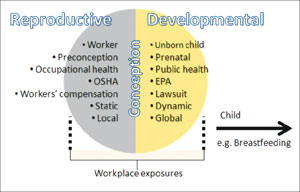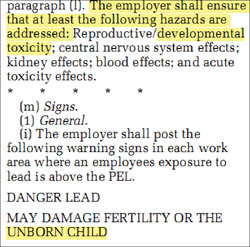

Figure 1
Workplace Reproductive/Developmental Hazards
Workplace Reproductive/Developmental Hazards
First, let’s consider the term “unborn child.” U.S. employers will not have a choice if this term is politically correct or not. The term is mandated under the United Nation’s Globally Harmonized System for Chemical Labeling (GHS), and where applicable will appear as a precautionary (P) or hazard (H) statement on chemical product labels, safety data sheets, and signs. To learn more about P and H statements under GHS visit http:// www.ilpi.com/MSDS/ref/hstatements.html.
An example of the term unborn child used as an H statement on an SDS is shown in Figure 2. Figure 2 is a clip from a current SDS developed by Glenn Springs Holding, Inc.; Dallas, TX (the entire SDS can be found at http://msds.oxy.com/DWFiles/M41280_ROW_ BE%233.pdf). Manganese in the product triggers the H360 statement. The yellow highlight is for purpose of this article only and does not appear on the SDS. The SDS is GHS compliant now because the manufacturer ships the product globally. GHS is underway in Europe and many Asian and other countries.
If your company is global, it is probably doing GHS now; if not, wait for the U.S. to catch up. Regardless of what the U.S. does or doesn’t do with GHS, if you get chemical products from a global supplier, GHS is coming your way.

Figure 2 - SDS H360 statement for unborn child
OSHA GHS
OSHA issued its proposed rule to align the GHS with the agency’s hazard communication standard on September 30, 2009. The proposed rule can be found at http://edocket.access.gpo.gov/2009/pdf/E9-22483. pdf. OSHA defines the differences between the terms reproductive and developmental on page 50463 of the proposed rule. Reproductive effect interferes with an employee’s fertility. Development “interferes with the normal development of the conceptus either before or after birth, which is induced during pregnancy or results from parental exposure.”Figure 3 shows how the OSHA sign and label for lead (i.e. OSHA substance specific standards) must change to meet GHS. Yellow highlights are for purpose of this article and do not appear within the proposed rule.
When the Hazcom rule is final (assumes the language in Figure 3 is unchanged), employers will be required by OSHA to address developmental toxicity and consider possible damage to the unborn child.
Can OSHA do this? Congress authorized OSHA to assure protection for healthy working adults. OSHA can establish law to protect the fertility of an employee, but it is difficult is understand how it can establish law to protect an unborn child. The permissible exposure limit for lead is established to protect an employee. An unborn child is not an employee and may or may not be more sensitive to exposure to lead.

Figure 3
Clip OSHA Proposed Hazcom Rule (page 50544)
Clip OSHA Proposed Hazcom Rule (page 50544)


